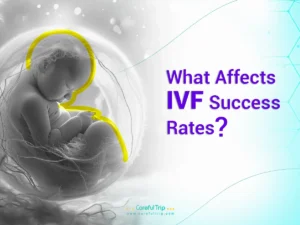
What Affects IVF Success Rates?
In vitro fertilization (IVF) has revolutionized reproductive medicine, offering hope to couples struggling with infertility. Despite continuous advances in technology and protocols, IVF success rates vary considerably across individuals and clinics. Understanding the array of medical, treatment-related, lifestyle, and regional factors that influence outcomes is essential for couples contemplating or undergoing IVF. This article provides an in-depth examination of the key determinants of IVF success, equipping readers with knowledge to optimize their chances of achieving a healthy pregnancy.
From the biological realities of a woman’s ovarian reserve and sperm quality to the subtleties of laboratory techniques and even the number of cycles attempted, IVF success hinges on multiple interlinked factors. Personal health behaviors such as nutrition, weight, and stress management are pivotal. By exploring these variables and outlining actionable strategies—including selecting the right clinic and leveraging organizations like CarefulTrip—this guide empowers couples to navigate their IVF journey confidently.
The Most Important Medical Factors
1. Woman’s Age
Female age remains the single most significant predictor of IVF success. As women age, their ovarian reserve and egg quality decline, reducing both the number of retrievable eggs and the likelihood of chromosomally normal embryos. Women under 35 generally experience success rates of 40–45% per cycle, which drop to around 20–30% for those aged 38–40, and below 10–15% for women over 40. Early fertility assessment—via antral follicle count and anti-Müllerian hormone (AMH) levels—can gauge ovarian reserve and inform realistic expectations.
2. Sperm Health
Male factor infertility accounts for up to half of all IVF cases. Key sperm parameters—count, motility, morphology, and DNA integrity—directly impact fertilization rates and embryo development. Advanced diagnostics such as sperm DNA fragmentation testing can uncover subclinical issues that standard semen analyses might miss. Improving sperm health through antioxidant therapy, lifestyle modification, and addressing underlying conditions (e.g., varicocele repair) can bolster IVF outcomes.
3. Uterine and Ovarian Health
A receptive endometrium and healthy ovarian function are critical for implantation and early embryonic development. Conditions such as uterine fibroids, polyps, adenomyosis, and congenital anomalies can impede implantation or increase miscarriage risk. Ovarian pathologies—like endometriomas or diminished ovarian reserve—also compromise egg quality and yield. Pre-IVF interventions, including hysteroscopic polypectomy or surgical excision of endometriotic cysts, may improve uterine and ovarian environments, thereby enhancing implantation potential.
4. Embryo Quality
Embryo quality, assessed by morphology and genetic screening, is a cornerstone of IVF success. Advances in time-lapse imaging and preimplantation genetic testing for aneuploidies (PGT-A) allow embryologists to select embryos with optimal developmental potential and correct chromosome numbers. Transferring a single, euploid blastocyst maximizes live birth rates while minimizing multiple gestation risks. Laboratories with stringent quality control and experienced embryologists yield higher-quality embryos and superior success rates.
Treatment-Related Factors
1. IVF Protocol Used (Long, Short, Natural)
The ovarian stimulation protocol—whether long agonist, antagonist, mini IVF, or natural cycle—affects egg yield and quality. Standard “long” protocols (GnRH agonist followed by gonadotropins) typically yield more eggs, advantageous for younger women with good ovarian reserve. Antagonist protocols reduce cycle length and ovarian hyperstimulation risk, benefiting higher-risk patients. Natural or minimal stimulation cycles use fewer drugs and may be suitable for poor responders or those wary of high estrogen levels, though they produce fewer eggs per cycle.
2. Experience of the Medical Team
The fertility specialists’ and embryologists’ skills and expertise directly influence IVF outcomes. Experienced physicians optimize stimulation regimens, manage complications, and precisely perform egg retrieval and embryo transfer. Seasoned embryologists maintain strict lab protocols, ensure optimal culture conditions, and select the best embryos. Clinics boasting board-certified reproductive endocrinologists and high case volumes often report superior success rates.
3. Quality of Laboratory and Technology Used
A state-of-the-art IVF laboratory with advanced incubators, time-lapse imaging, and stringent air and temperature controls is essential for embryo development. Utilization of cutting-edge genetic testing (PGT-A), laser-assisted hatching, and vitrification for cryopreservation enhances success. Proper quality assurance measures—daily equipment calibration, media sterility checks, and rigorous staff training—ensure a controlled environment that supports embryo viability.
Lifestyle and Personal Health Factors
1. Body Weight (BMI) and Its Impact
Both underweight and overweight statuses compromise IVF outcomes. A BMI between 18.5 and 24.9 is associated with higher pregnancy and live birth rates. Obesity (BMI ≥30) can impair egg quality, reduce ovarian response, and increase miscarriage risk, while underweight (BMI <18.5) may lead to poor ovarian response and implantation failures. Achieving and maintaining a healthy weight through balanced nutrition and exercise optimizes hormonal balance and endometrial receptivity.
2. Smoking, Alcohol, and Caffeine
Cigarette smoking is unequivocally linked to reduced ovarian reserve, poorer egg quality, and lower implantation rates, as well as increased miscarriage risk. Alcohol consumption—even moderate—can detrimentally affect fertility, with evidence suggesting reduced sperm quality and embryo viability. While the impact of caffeine is less clear, limiting intake to under 200 mg per day (about one 12-oz cup of coffee) is prudent. Complete avoidance of tobacco and minimization of alcohol and caffeine intake are recommended for couples pursuing IVF.
3. Stress and Sleep: The Mind-Body Connection
Psychological stress and sleep disturbances negatively influence reproductive hormones and IVF outcomes. Cortisol and adrenaline dysregulation can impair ovarian response and endometrial receptivity. Mind-body interventions—such as cognitive-behavioral therapy, mindfulness meditation, yoga, and acupuncture—have been shown to reduce anxiety, improve sleep quality, and modestly enhance IVF success rates. Prioritizing stress management and restorative sleep (7–9 hours nightly) supports the hormonal milieu needed for optimal fertility.
Number of IVF Cycles
1. Why First Attempt May Not Always Work
IVF is complex, and the first cycle may fail due to suboptimal ovarian response, poor embryo quality, or implantation issues. Learning from each cycle—adjusting drug dosages, refining stimulation protocols, or addressing uterine factors—can improve outcomes in subsequent attempts. Understanding that multiple cycles may be needed helps set realistic expectations and encourages perseverance.
2. Cumulative Success Rates Over Multiple Cycles
While per-cycle success rates provide a snapshot, cumulative live birth rates over consecutive cycles offer a broader perspective. For women under 35, cumulative live birth rates approach 60–70% after three IVF cycles; rates remain significant even for women in their early 40s when multiple cycles are pursued. Couples should discuss cumulative probabilities with their clinic to guide decision-making and treatment planning.
How to Improve Your Chances of IVF Success Rates
1. Things to Do Before Your Cycle Begins
- Preconception Evaluation: Check ovarian reserve (AMH, AFC), uterine health (hysteroscopy), and male factor (semen analysis).
- Optimize Health: Address thyroid dysfunction, diabetes, and other chronic conditions.
- Supplementation: Begin folic acid, vitamin D, and a prenatal multivitamin at least three months prior.
2. Diet, Supplements, and Exercise
- Balanced Diet: Emphasize high-quality protein, whole grains, fruits, vegetables, and healthy fats (Mediterranean diet).
- Supplements: CoQ10, DHEA for diminished ovarian reserve, myo-inositol for PCOS, and omega-3 fatty acids.
- Regular Exercise: Moderate activity (30 minutes/day) improves insulin sensitivity and mood; avoid excessive high-intensity training during stimulation.
3. Choosing the Right Clinic
- Success Rates: Review standardized clinic success data (e.g., CDC, SART, ESHRE).
- Accreditations: Look for ISO certification, CAP accreditation, and ESHRE‐certified labs.
- Comprehensive Care: Ensure availability of counseling, nutrition, and integrative therapies.
IVF Success Rates by Country and Region
1. Global Average Success Rates
Worldwide, IVF success rates per cycle vary from 25% to 40% for women under 35, decreasing with age. Variability stems from differences in clinical protocols, patient demographics, and reporting standards.
2. Why Some Countries (Like Iran, Spain, or Turkey) Stand Out
- Iran: High-volume clinics, state-of-the-art technology, and low treatment costs attract medical tourists, achieving success rates comparable to Western Europe.
- Spain: Liberal regulations, wide availability of donor gametes, and robust regulatory oversight yield per-cycle success rates above 35% in many centers.
- Turkey: Government investment in healthcare infrastructure and experienced medical teams have elevated IVF success rates to around 30–35% per cycle.
CarefulTrip’s Role in Enhancing IVF Outcomes
CarefulTrip specializes in medical facilitation for international patients seeking fertility treatments, particularly in Iran. Leveraging partnerships with Iran’s leading fertility clinic, MOM Infertility Treatment Center, CarefulTrip provides end-to-end support:
- Consultation & Planning: Personalized assessments match couples with the most suitable clinics and protocols.
- Logistics & Travel: Managing visas, accommodations, and local transportation ensures seamless journeys.
- On-Ground Support: Multilingual coordinators facilitate medical appointments and ensure clear communication with healthcare teams.
- Emotional & Cultural Care: Culturally sensitive counseling and support groups reduce stress, a known factor in IVF success.
With CarefulTrip, couples benefit from high-quality, cost-effective IVF services and comprehensive support that addresses medical and emotional needs.
In collaboration with the MOM Infertility Clinic, CarefulTrip’s IVF services yield 60-65% success rates, which are on par with the world’s best IVF centers.
Final Words
IVF success hinges on a multifaceted interplay of medical, treatment-related, lifestyle, and regional factors. By understanding how age, gamete quality, lab technology, and personal health behaviors influence outcomes, couples can take proactive steps to optimize their chances. Persistence across multiple cycles, combined with tailored pre-treatment preparation comprising nutritional optimization, stress management, and selecting a reputable clinic, further enhances the likelihood of a healthy pregnancy. Organizations like CarefulTrip simplify the complex IVF journey by integrating medical expertise with logistical and emotional support. Armed with evidence-based strategies and compassionate care, hopeful parents-to-be can approach IVF with confidence and resilience, keeping the dream of parenthood well within reach.
References
- Cinelli, M., et al. “Age‐Related Decline in Ovarian Reserve: Impact on IVF Success Rates.” Fertility and Sterility, 2023.
- Practice Committee of the American Society for Reproductive Medicine. “Fertility and Male Aging: Sperm Quality and Pregnancy Outcomes.” ASRM Guidelines, 2022.
- Smith, J. & Brown, L. “Uterine Pathologies and IVF Outcomes: A Meta‐Analysis.” Human Reproduction Update, 2021.
- European Society of Human Reproduction and Embryology. “Laboratory Quality Control in Assisted Reproduction.” ESHRE Guidelines, 2022.
- Gaskins, A. et al. “Body Mass Index and IVF Outcomes: Clinical Implications.” Obesity Reviews, 2023.
- Vander Borght, M., Wyns, C. “Fertility and Assisted Reproductive Techniques: Impact of Lifestyle Factors.” Endocrine Reviews, 2022.
- Centers for Disease Control and Prevention. “2019 Assisted Reproductive Technology National Summary Report.” CDC.gov, 2021.
- European IVF‐Monitoring Consortium (EIM) for ESHRE. “ART in Europe: 2020 Results.” Human Reproduction Open, 2022.
